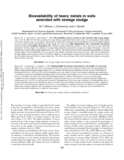Mostrar el registro sencillo del ítem
Bioavailability of heavy metals in soils amended with sewage sludge
| dc.creator | Morera Luzán, María Teresa | es_ES |
| dc.creator | Echeverría Morrás, Jesús | es_ES |
| dc.creator | Garrido Segovia, Julián José | es_ES |
| dc.date.accessioned | 2014-06-05T07:57:23Z | |
| dc.date.available | 2014-06-05T07:57:23Z | |
| dc.date.issued | 2002 | |
| dc.identifier.issn | 0008-4271 (print) | |
| dc.identifier.issn | 1918-1841 (electronic) | |
| dc.identifier.other | 930 | |
| dc.identifier.uri | https://hdl.handle.net/2454/10748 | |
| dc.description.abstract | The recycling of sewage sludge to agricultural land results in the slow accumulation of potentially toxic heavy metals in soils. A greenhouse experiment was conducted to determine the bioavailability of Cu, Ni, Pb and Zn applied to soils in urban anaerobically stabilized sewage sludge. The soils were Lithic Haplumbrept (Lh), Calcixerollic Xerochrept (Cx1 and Cx2) and Paralithic Xerorthent (Px). Sunflower plants (Helianthus annuus L) were grown in. the soils following amendment with the sludge. The addition of sewage sludge markedly increased the average dry weight of the plants in the soils that had lower yields without sludge addition (Lh, Cx2, and Px). The acid pH of the Lh soil favoured the bioavailability of Zn from sewage sludge. The bioavailability of Cu was greater in the alkaline soils than in the acidic soil (Lh), which can be attributed to the high organic matter content of the Lh soil which complexes Cu and impairs its uptake by the plants. The concentration of metals in the plants increased with the sewage sludge dose. The effect of the soil type on the metal concentration in plants was greater that the effect of the dose. | en |
| dc.description.sponsorship | This work was supported by a project of Instituto Nacional de Investigación y Tecnología Agraria y Alimentación (INIA SC94-026) | en |
| dc.format.mimetype | application/pdf | en |
| dc.language.iso | eng | en |
| dc.publisher | Agricultural Institute of Canada | en |
| dc.relation.ispartof | Canadian Journal of Soil Science, 2002, 82(4). Págs. 433-438 | en |
| dc.subject | Soils | en |
| dc.subject | Sewage sludge | en |
| dc.subject | Heavy metals | en |
| dc.subject | Bioavailability | en |
| dc.subject | Sunflower | en |
| dc.subject | Trace metals | en |
| dc.subject | Availability | en |
| dc.subject | Plants | en |
| dc.subject | Copper | en |
| dc.subject | Nickel | en |
| dc.subject | Zinc | en |
| dc.title | Bioavailability of heavy metals in soils amended with sewage sludge | en |
| dc.type | Artículo / Artikulua | es |
| dc.type | info:eu-repo/semantics/article | en |
| dc.contributor.department | Química Aplicada | es_ES |
| dc.contributor.department | Kimika Aplikatua | eu |
| dc.rights.accessRights | Acceso abierto / Sarbide irekia | es |
| dc.rights.accessRights | info:eu-repo/semantics/openAccess | en |
| dc.identifier.doi | 10.4141/S01-072 | |
| dc.relation.publisherversion | https://dx.doi.org/10.4141/S01-072 | |
| dc.type.version | Versión aceptada / Onetsi den bertsioa | es |
| dc.type.version | info:eu-repo/semantics/acceptedVersion | en |


